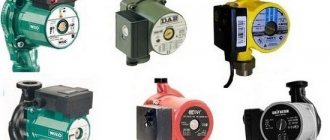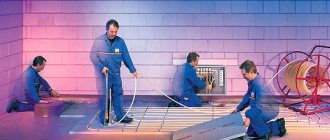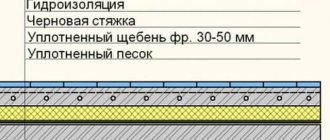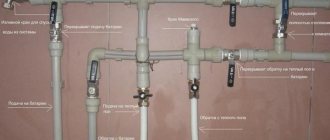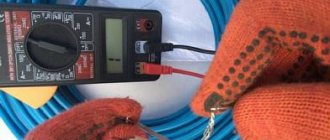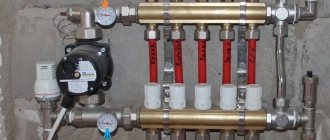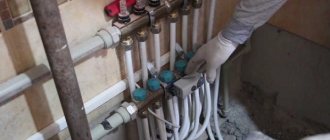Warm floor does not work (does not heat)
The most common cause of this situation is a malfunction of the thermostat or lack of power. A heated film floor cannot go out of order all at once (all pieces of film), since the heating element is divided into sections, the carbon strips are conductors connected in parallel. In addition, the entire floor surface is divided into separate sections (film sections).
There is no voltage at the thermostat. Check with a multimeter or an indicator screwdriver at terminals 1 and 2 of the thermostat.
Thermostat malfunction. It is checked by measuring the voltage at the output terminals (usually terminals 3 and 4) of the thermostat. When the thermostat is turned on and a command is given to turn on the heating (formed by the thermostat), a voltage of 220-230V should be present at these terminals. If this is the case, then the thermostat is working; if not, then it needs to be replaced.
Malfunction of the supply wire going from the thermostat to the film floor (break, squeezing, burning, etc.). It is checked by measuring the resistance between the supply wires of the heated floor with the thermostat turned off. High resistance indicates a break in the supply wire. It needs to be examined.
Heating cable fault
We have already checked the thermostat and floor heating sensor, but the fault has not yet been found? We begin checking the heating cable. In order to determine the load created by the heating cable, it is necessary to measure its resistance. We compare the obtained data with the indicators specified in the technical data sheet of the device.
Based on the instrument readings, it is possible to determine the cause of the heated floor malfunction. Data below the standard indicates damage to the outer sheath of the heating cable. If the resistance tends to zero, the reason is mechanical damage to the cable or burnout of the coupling. Unstable values indicate the presence of water under the shell. If the multimeter shows the “infinity” sign, the problem is a burnout or breakage of the heating element located in the coupling of the device.
Having carried out diagnostics and identified a malfunction of the heating system, you can fix it yourself, or seek the help of specialists. But you should definitely take into account that finding the place of damage to the heating cable in the screed is only possible with the help of special equipment. If such a situation arises, we advise you to contact a service center, whose technicians will repair the heating cable with minimal damage to the floor covering.
You can get advice, additional information about products and buy electric heated floors in our online store, by calling 8.0 or in one of the stores in your city.
“The warm floor does not heat. Causes of malfunction and solutions" LLC "Warm Floor", 2021 Chain of branded stores "Warm Floor" is a registered trademark. Copying and using texts from the website of the “WARM FLOOR” chain of branded stores without indicating the source is PROHIBITED!
A certain part of the heated floor area does not heat up
Part of the carbon carbon strips is damaged - usually mechanical damage to the protective layer of the film. A visual inspection of the area that is not heating is carried out.
Unreliable contact between the supply wire and the current-carrying strip on any section of the heated floor or mechanical damage to the current-carrying strip of the film floor. This is true if several pieces of film flooring are laid in the room and some of them work (heat) and some do not. It is necessary to inspect all connecting contacts of the power cable and the heated floor and identify the location of the malfunction. To do this, open up that part of the floor under which the film is not heated.
The rules for making connections are described in detail in the corresponding section.
Electric underfloor heating does not heat - causes and solutions
Electric heated floors receive energy from the electrical network. They stop working when the heating elements - the thermostat or temperature sensor - fail, as a result of which the underfloor heating stops heating.
In the article, we will look at the main problems, although there may be other breakdowns that are not described in this manual.
We will tell you what to do if the electric heated floor does not work, how to make repairs and put the device into operation for the first time.
Heated floor repair (diagnostics)
Voltage problems
If there is no heating of the electric heated floor, you should first check the availability of power. To do this, you need to look at the thermostat, there is a special indicator there and if it lights up, it means current is flowing. If it does not light, then a visual inspection of the available contacts is performed, and then the voltage is determined using a multimeter.
If there is voltage at the input, you need to make sure that electrical energy reaches the cable or film. Then the settings are checked (perhaps the minimum heating was set incorrectly) and the reliability of the contacts (connecting wires to the terminals) - if the contact is poor, the floor stops heating.
After this, the voltage at the output is determined - at the junction of the wires with the thermostat. If it does not correspond to the indicators in the network, then the regulator needs to be replaced.
Insufficient heating may indicate low voltage; a voltage stabilizer must be installed.
Errors during installation work
If there is heating of the floor, but it is weak, the device often turns on, does not reach a degree, or has stopped working altogether - the reason is improper installation. Then you will need to diagnose all elements.
If the floor does not warm up above 30 degrees:
- The power is incorrectly determined;
- High heat loss - poor insulation;
- The heating elements are placed incorrectly or the pitch is selected;
- Thick screed;
- The temperature sensor is located close to the surface.
If such mistakes are made, then you will have to dismantle the floor and re-lay it all over again.
The floor may not work effectively if the sensor is located close to the cable. If it is placed in a corrugation, then it is easy to push it further, or, on the contrary, pull it out by 5 cm - this can solve the problem.
A warm electric floor will not function correctly if the installation rules are not followed - the heater is placed under heavy objects.
Another point that leads to device failure is inaccurate installation (wire break) . Then you will have to disassemble the structure, look for the area of the gust, and eliminate the problem area.
Thermostat does not work
If the heated floor does not turn on, then the reason may be in the thermostat - the relay has broken down or the electronic circuit has become unusable. You can find out that the device is faulty by directly connecting the heated floor to the network. If it gets hot, then the problem is in the regulator.
You need to start making repairs by removing the device from its seat so that the terminals are visible.
Then you need to check with a multimeter or voltmeter whether 220 W is supplied to the thermostat.
If the required voltage is available, you need to make sure that the contacts are reliable and the cable is connected correctly. The wiring may fall out due to weak contact, and the floor program will show an error - “Sensor break”.
If everything is normal, then the resistance is measured - the contacts of the multimeter and the thermostat are connected. The obtained data should be close to the passport data. If they are equal to 0, then the regulator is faulty and must be sent for repair or replaced with a new one.
also check whether the device is working or not as follows . You need to connect a light bulb to the terminals to which the underfloor heating wires are connected. Then apply voltage while constantly unscrewing the temperature switch. If the device is working properly, the light will light up when room temperature is reached.
Replacing the device yourself is easy. But first, you need to turn off the power. Then open the front panel, install a new one in place of the old thermostat, and connect all the wires to it.
Thermostats do not have fuses that protect against short circuits. Their function in electric floors is assigned to the automatic switch and RCD.
Temperature sensor does not work
Another common reason why a heated floor does not heat when the thermostat is running is a problem with the temperature sensor. If it fails, the floor will not turn off, which will increase energy costs.
When checking a temperature sensor, you need to measure its resistance and compare the results with the passport data. Small deviations are acceptable; if significant differences occur, the device must be replaced.
If you installed the sensor correctly - in the corrugation - then changing it is not difficult. There is no need to dismantle the floor and screed, you only need to open the wall a little. The temperature sensor is pulled out of the corrugation and replaced with a new one.
Damage to the heating element
If after the checks you have found that the thermostat and temperature sensor are working properly, and all contact connections are of good quality, then you need to look for the problem in the cable.
The cable could break during installation. The presence of a short circuit can be checked with a multimeter, but more sophisticated equipment is required to determine the location of the break.
First, the cable is disconnected from the thermostat, and the tester measures the resistance between the two wires. It must correspond to the factory settings - 11 - 700 Ohms. The permissible discrepancy is within 5%.
If the value is 0, then there is a short circuit. This happens when the system overheats or when the cable cross-section is incorrectly calculated. If the device displays infinity, it means there is a wire break or it is burned out. Then you should check the connections.
If the readings are in hundreds of Ohms, then you need to connect a 2500 V pressure gauge and apply an increased voltage level between the braid and cable cores. The value is 0 - the cable is broken or the contact in the coupling is lost, it is necessary to determine the location of the damage.
To identify the exact location of the malfunction you will need:
- transformer;
- signal generator;
- electromagnetic sensor;
- thermal imager.
The procedure is as follows:
- we burn through the place where the insulation is weak - we apply increased voltage there (10 kV), if there is a voltage in the conductors of 350 V, this leads to the formation of a welding arc;
- at the same time, the generator supplies signals to the cable;
- We use an electric sensor to find a breakdown;
- We carefully scan the entire area with a thermal imager. There will be an increased temperature at the burn site.
When using heating mats, the search is much easier, because they are closer to the surface.
If, after checking with a multimeter (see instructions on how to check), a short circuit between the wires is detected, then burning is not necessary. You can immediately connect the generator and look for the point of damage.
After identifying the location of the damage, you can proceed directly to repairing the underfloor heating cable. The step-by-step instructions are as follows:
- At the site of identified damage, the floor covering is dismantled.
- The screed or glue comes off.
- More often, the reason is that contact in the coupling is lost. It is heated with a hair dryer - this will make the process of cutting it easier.
- The coupling is sheared at the point of the gust.
- The veins at the break points are cleaned.
- The contact sleeve is installed; first, a coupling should be placed on the cable. The connection point must be wrapped with electrical tape.
- The coupling is moved to the connected area and soldered using a hair dryer for tightness.
For a simple cable break, the process is the same. Only the coupling is missing, which needs to be cut off.
Failure of infrared film
Infrared film belongs to electric floors, and it may not work for the reasons mentioned above: no power, incorrect installation, a broken thermostat or temperature sensor.
But the film has its own characteristics - it is connected to the network with wires that are connected to the copper bus with clamps. If contact is poor, the metal oxidizes, causing an open circuit.
Therefore, if all the devices have been checked, but the floor still does not heat, then the contacts need to be examined . They should be tightened, or the clamp should be replaced (if it is broken).
Equipment selected incorrectly
Insufficient functioning of the heated floor may be due to an incorrectly selected model. Before purchasing, you need to determine the tasks of the underfloor heating system - it will be additional or main heating.
An economical model that can warm the floor up to 30 degrees is suitable as additional heating. If this is the only heating system, then the power should be greater, which can warm the surface up to 40 degrees.
When choosing a device, you should take into account heat loss and the distance between heaters.
Damage to the floor covering above the heated floor
Local overheating of the film floor area. Film heated floors are afraid of being “locked”. If local overheating occurs (a bulky object such as a mattress or pillow is left on the floor), the heat exchange is disrupted and the temperature in that area rises, which leads to damage to the floor covering. At the same time, the heated floor itself works properly. Film heated floors must not be laid under furniture or other objects that impair the transfer of heat to the surrounding space.
Malfunctions of infrared heated floors
Despite the fact that this is the newest and most modern heating method, there are problems that arise during installation or operation:
- When powering the system from the mains, wires are used that are attached to a copper element located at the edge of the film. Fastening is done using clamps. If you don't press hard enough, the metal will begin to oxidize over time. This will lead to an open circuit and a cold floor. To correct the situation, you need to clean and reconnect.
- During operation, the thermostat, which is responsible for regulating the degree of heating, may fail. With this breakdown, incorrect operation occurs, the temperature does not correspond to the set one, or heating takes too long. This can only be fixed by replacing the broken element.
- If the quality of heating has decreased significantly. and the temperature in the house does not rise to a comfortable value, it is necessary to test the serviceability of the electrical strip element. If it malfunctions, you can only replace it with a new one, since it is practically irreparable.
If you are doing your first startup, the question often arises, how long does it take for the floor to heat up? Initially, you need to set the temperature to 40 degrees, and in the end you will have the desired, or more precisely, comfortable surface temperature for a person of 36-38 degrees, in about 30-40 minutes.
We invite you to watch a video about repairing a heated floor with your own hands:
Film heated floor “buzzes”
Sometimes, when installing a film heated floor, an effect such as “buzzing” of the film occurs, which manifests itself in the form of low-frequency sound vibrations and is audibly perceived as a crackling or buzzing sound on the surface of the film. When the power is turned off, this effect disappears.
The reason for the appearance of this crackling sound is resonance phenomena in the “Power supply - film floor” system, which can arise due to the influence of harmonics of the main frequency of the supply network (50 Hz) on the film. The fact is that various types of deviations may be present in the supply network: a surge and dip in the amplitude of the network voltage, the presence of high-frequency interference that occurs during equipment operation, etc. All these deviations, under certain conditions, to one degree or another can lead to such a phenomenon as “buzzing” of the film.
Attention! The "buzzing" or "crackling" effect is not a film malfunction.
Recommendations for eliminating film “buzz”
- Check the thermal insulation material under the film - it must be non-conductive (based on lavsan). Alternatively, you can try turning the insulation over with the reflective side down.
- Swap phase L and zero N on the regulator.
- Check the installation of the film - the copper current-carrying strips should be at the bottom.
- Current-carrying wires from the film to the thermostat should not run along the surface of the film itself; they should be routed around the perimeter of the room.
- The room must be dry. The film can sometimes hum if there is dampness in the room (for example, in bathrooms or if the screed in the room is not completely dry, etc.)
- Sometimes the film can hum if it is laid along the floor slabs (the main fittings are located there). You can try turning the film 90 degrees and placing it across the slabs. The influence of the floor structure can be checked as follows: raise a section of the film above the floor to a height of 0.5-1 m and listen to the hum. If the film continues to hum, then the floor construction is not affecting the film.
Cable underfloor heating does not heat well: main reasons
Before making sudden decisions about faulty operation, you need to objectively evaluate the operation of the system. To do this you need to follow 2 simple steps:
- Run the heating for 30–90 minutes. The heating time directly depends on the quality of the insulation and the thickness of the finishing coating.
- Wait until the temperature mode corresponds to the temperature set on the sensor. After the working surface is properly heated, the device will turn off and the indicator will stop lighting.
Repair of warm electric floors will be necessary only if the heating time is significantly longer than normal, and the light on the thermostat does not turn off. It's time to find out why the warm electric floor does not work. The following factors may be to blame for this:
- Incorrect selection of heating wires. The type and power characteristics of the cable are selected based on their technical conditions for working with the floor. When designing independently, there is always a risk of making incorrect calculations. Only qualified specialists will help correct such defects. Therefore, during installation and development you need to be extremely careful.
- Inaccuracies during installation. The installer may not calculate all the nuances of working with the structure, especially if he is inexperienced. The performance of the system depends on the correct installation of the temperature sensor. If it is installed incorrectly, then you may never wait for the system to fully heat up. Accordingly, the owner of the house will face a cold winter.
- Damage to wiring. If screeding or tiling was done, there is a possibility that the cable was damaged.
- Temperature sensor failure. Connections need to be checked. The terminals must be in a tightly tightened position. It is also worth checking the voltage at the wire terminals. The value should be the same as when the temperature sensor is turned on. In addition, it is necessary to measure the resistance of the device.
- Low voltage. Repairs to electric heated floors may occur due to improper power supply. Low voltage significantly reduces the power of the entire heating system. The issue can be resolved by installing a stabilizer. This will ensure the proper level of power density by increasing the voltage.
The greater the voltage drop, the lower the floor power!
- Lack of thermal insulation, incorrectly selected material thickness. The shortcoming is especially noticeable on the first floors. The thinner the thermal insulation layer, the greater the heat loss value. Users often complain that the electric heated floor does not heat and look for the causes of the malfunction. But the point is not in the heating system itself, but in incorrect calculations of thermal insulation. If a heated floor is already installed and there is no way to increase its efficiency, then it is worth reducing heat loss by installing additional insulating materials.
The floor “pierces” with electricity
The main reason is poor insulation of the connections of the supply wire and current-carrying strips. All terminals and connections must be inspected.
Violation of the insulation of the supply wire - a problem can arise during long-term operation of the heated floor if the connecting wires are installed incorrectly (especially if they are installed overlapping).
There is a lot of humidity in the room - for example, there was a water leak or moisture somehow got under the finishing coating onto the heated floor. In this case, the connections between the film floor and the supply wire are a “weak” point that must be checked first.
Electric floor heating thermostat repair
Among the possible reasons why an electric heated floor began to heat poorly is the incorrect installation of the temperature sensor. Such a breakdown manifests itself as follows: from time to time the thermostat will turn off, despite the fact that the floor has not yet warmed up.
Why doesn't the electric heated floor heat? Thermostat repair, video:
Among the possible reasons for this situation may be incorrect installation of the device. Most often, an inexperienced home “specialist” places it very close to the heating cable. Often the sensor lies directly on the heating wires. What else can you expect from a device in such a situation? Of course, it will “think” that the floor has heated up to the limit and will turn off for fire safety reasons.
Repair of the electric floor heating thermostat can be avoided if the device is installed correctly. Correct installation implies not only correct placement of the sensor, but also adjustment of the temperature regime with an accuracy of 2 °C. A modern infrared thermometer will allow you to check the operation of the sensor.
If the thermostat is constantly on (this can be seen by the lit indicator), then you need to think about checking the heated floor, and then find out the cause of the breakdown.
The system does not work: causes and solutions to the problem
A water heated floor is a complex system of interconnected elements. Problems arise due to various factors :
- Incorrect installation . Heating problems appear if insufficient insulation was used during installation. This leads to high heat loss. There is only one solution - to open the floor covering and dismantle the screed and pipes.
- Incorrect calculations during design . An error in the selection of components according to parameters does not allow the heating system to function fully.
- Lack of energy . Low network voltage and insufficient boiler power cause interruptions in heating.
- Pipeline damage . A leak causes a sharp drop in pressure in the pipes, reducing the amount of water in the system. The location of the leak is determined visually or with a thermal imager. Then they open the floor covering and screed, cut out the damaged section of the pipe and replace it with a new one.
- Malfunction of the thermostat, circulation pump . In the absence of other reasons, inspect the power equipment for breakdowns. Use an indicator screwdriver or a multimeter to check the voltage supply. If a general check of the thermostat does not reveal a problem, check the resistance of its terminals - perhaps the reason is in the temperature sensors.
Attention
If an independent search for the reasons why the heated floor has stopped heating does not produce results, you need to seek advice from a professional.
